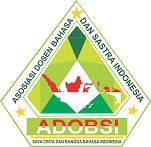ANALISIS WACANA KRITIS PADA KUMPULAN ESAI MUSLIM TANPA MASJID KARYA KUNTOWIJOYO
DOI:
https://doi.org/10.21776/ub.hastawiyata.2021.004.01.05Keywords:
critical discourse analysis, use of texts, socio-cultural practices.Abstract
This study aims to determine the use of socio-cultural texts and practices in the text of the essay collection of Muslim Tanpa Masjid. This study uses a qualitative descriptive method, which is presenting data and not numbers. The data in this study were taken from the essay collection book entitled Muslim Tanpa Masjid the inform of essay text. The data is the text and socio-cultural practices in the essay text of theessay collection Muslim Tanpa Masjid. Sources of data in this study were 17 essay titles consisting of 6 religious essays, 5 cultural essays, and 6 political essays fromcollection of essays on Muslim Tanpa Masjid Kuntowijoyo's 2001. Based on the results of the study, it is known that in the representation in the sentence there are 18 forms of process consisting of 5 forms of events, 8 forms of action, 2 forms of process, and 3 forms of circumstances, and found 18 forms of participants consisting of 11 actors described as perpetrators and 7 described as victims. In addition, 20 explicit meanings and 16 implicit meanings were also found in the text of the collection of essays on Muslim Tanpa Masjid as well as socio-cultural practices which can be identified by connecting the text to the situation. With the results of the research, further researchers can use the book collection of essays on Muslim Tanpa Masjid as an object of study using hegemony studies because there are many essays that show the power of power. In addition, essay writers must be good at relating the text to the situation to be written. The essay should be easy for the reader to understand.
References
Chaer, A., & Agustina, Le. (2010). Sosiolinguistik Perkenalan Awal. Jakarta: PT. Rineka Cipta.
Darma, Y. A. (2014). Analisis Wacana Kritis dalam Multiperspektif. Bandung: PT. Revika Aditama.
Ghufron, S. (2015). Kesalahan Berbahasa: Teori dan Aplikasi. Yogyakarta: Ombak.
Mulyana. (2005). Kanjian Wacana Teori, Metode & Aplikasi, Prinsip-Prinsip Analisis Wacana. Yogyakarta: Tiara Wacana.
Mustofa. (2014). ANALISIS WACANA KRITIS ( AWK ) DALAM CERPEN DUA SAHABAT KARYA BUDI DARMA : KONTEKS. BASTRA, 1(1), 13–22. Retrieved from https://hastawiyata.ub.ac.id/index.php/hastawiyata/article/view/41
Santoso, A. (2012). Studi Bahasa Kritis Menguak Bahasa Membongkar Kuasa. Bandung: Mandar Maju.
Sutardi, & Kurniawan, H. (2011). Penulisan Sastra Kreatif. Lamongan: CV Pustaka Ilalang.














